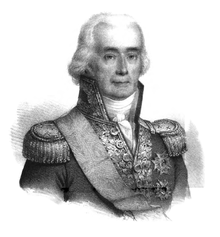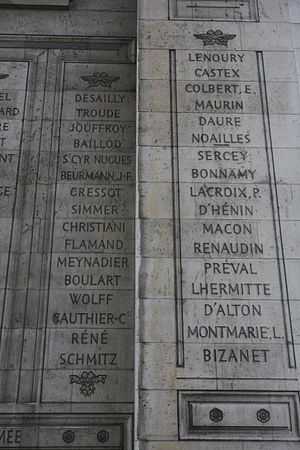Pierre César Charles de Sercey
| Pierre César Charles de Sercey | |
|---|---|
 | |
| Born |
1753 near Autin |
| Died |
1836 Paris |
| Allegiance |
Kingdom of France, First French Republic |
| Service/branch | French Navy |
| Years of service | 1766-1803 |
| Rank | vice-admiral |
| Commands held | Indian Ocean squadron |
| Battles/wars |
American Revolutionary War, French Revolutionary Wars |
Pierre César Charles de Sercey (near Autin, 1753 - Paris, 1836) was a French admiral, most notable for commanding French naval forces in the Indian Ocean from 1796 to 1800. His name is engraved on the Arc de triomphe.
Life
Early life
From an old noble family but orphaned very young, he embarked on the Légère aged 13 in 1766, before it sailed for the Antilles. He then voyaged in the Indian Ocean from 1767 to 1769, entering the gardes-marine in 1770 on Mauritius.
He served on the scow Gros Ventre in Kerguelen's expeditions (1772–1774). Separated from the expedition's flagship Fortune by a storm, the Gros Ventre was considered lost with all hands, but after a difficult voyage it managed to make it back to France on its own. Kerguelen was accused (probably justly) of having abandoned the Gros Ventre when the latter was in difficulties and of being uninterested in its survival.
American Revolutionary War
Rising to ensign in 1777, he served on the frigate Belle Poule in the English Channel then on the Triton in Orvilliers's fleet in 1779. He commanded the cutter Sans Pareil in Guichen's fleet and fought in the battles over Dominica in April and May 1780. Captured by HMS Phoenix and two frigates, he quickly became the subject of a prisoner exchange and next commanded the cutter Serpent in the capture of Pensacola (May 1781). Then, having risen to lieutenant de vaisseau, he became second officer of the frigate Nymphe in 1782 and was thus in several battles, notably the capture of HMS Argo in February 1783 (in which battle Sercey took over command of the Nymphe when her captain was killed). He then campaigned in the Antilles from 1787 to 1792, commanding the frigate Ariel then the frigate Surveillante.
Revolution and the Indian Ocean
Rising to capitaine de vaisseau in 1792 and contre-amiral in January 1793, he commanded a division sent to Saint Domingue, but as an aristocrat was suspected of wanting to emigrate and so was arrested during the Reign of Terror. He was returned to his rank under the French Directory naval ministry of Truguet.
He then commanded a division of four frigates setting out from Rochefort to take reinforcements, munitions and two Directory commissioners (Baco and Burnel) to Mauritius.[1] Capturing several ships en route, he reached the Indian Ocean, where the forces already stationed at Mauritus were also put under his command. He thus had a small squadron of the corvette Brûle Gueule (commanded by Jean François Bruneau de la Souchais) and 7 frigates with talented captains:
- Forte (Commander Beaulieu-Leloup)
- Prudente (Magon)
- Régénérée (Willaumez)
- Vertu (Lhermitte)
- Seine (Latour and later Bigot)
- Cybèle (Tréhouart)
- Preneuse (Marquès)
These means were limited in the face of the strong Royal Navy presence in the region, of 10 ships of the line and 10 frigates. Moreover, Mauritius had no serious means of resupply or repairs since all troops sent from mainland France had to struggle against the hostility of the colonists, the colonial assembly and governor Malartic, all so worried by the rebellion on the Mascarene Islands that they proclaimed they would not put into effect the abolition of slavery decided upon in Paris. The colony refused to give Sercey's division any support and Sercey was reproached by Truguet for not intervening to support Baco and Burnel (expelled on arrival by the colonists).
Sercey compensated for his force's weakness by keeping his ships constantly at sea and (operating a little like a private privateer) raising money for provisions by selling captured ships (including many East Indiamen). Fear of being unable to repair his frigates and his express orders to avoid giving battle sometimes led him to behave timidly. For example, he refused to capitalise on the manhandling of the ships of the line HMS Arrogant and HMS Victorious by his frigates in the Action of 8 September 1796, refraining from pressing the issue and capturing the ship. His prudence also led him to miss a "China convoy" in the Bali Strait, made up of five slow heavy ships of the East India Company under commodore Charles Lennox of the Woodford, and including the Ocean. This convoy formed a line of battle on 28 January 1797 and thus tricked Sercey (at a distance) into believing they were warships and avoiding battle with them.[2] This bluff made Lennox a celebrity and was greeted with rejoicing by the British press.
The end of Sercey's division
However, in 1798, though none of his ships had been captured, they were starting to show signs of wear and tear and little by little had to return to France for repair, depriving him of Vertu, Régénérée and Seine. Moreover, profiting by Sercey's absence, governor Malartic requisitioned Forte and Prudente as private vessels, armed them as privateers and put them under the command of incompetent captains, leading to both ships being captured at the start of 1799. This left Sercey only the frigate Preneuse (captain Lhermitte) and the corvette Brûle Gueule - far too small a force for such a large theatre. He thus looked for support from major Spanish naval forces in the area, setting up his headquarters at Surabaya to be closer to the Spanish base at Manila. Even so, he was unable to establish a true offensive alliance, with the Spanish captains feeling more sympathy with Great Britain (officially their enemy) than for republican and anti-religious France and with the few attempted joint Franco-Spanish operations being defeated.
Returning to Mauritius with his last two remaining ships, for three weeks Sercey succeeded in beating off attacks from two ships of the line and two frigates which were blockading the island, in the second battle of the Black River. Nevertheless, despite its captain's exceptional talent, the Preneuse was finally destroyed by the British blockading forces in Mauritius's bay of Tombeau in December 1799, marking the end of Sercey's division and of the campaign.
Disgrace, retirement and death
He only returned to France in 1802, where he faced hostility from the naval minister Denis Decrès, who held him responsible for the fate of the Indian Ocean division. Disgusted by Decrès's attitude, Sercey returned to Mauritius, where he married and settled as a planter, playing an important role in the island's defence in the campaign that ended in its definitive capture by the British in 1810. He finally returned to France and was made vice-admiral in 1814 and a peer of France in 1832.
Titles and decorations

- Grand cross of the Légion d'Honneur
- Grand cross of the Ordre de Saint Louis
- Marquis
- Gentilhomme honoraire de la Chambre (1824)
- Order of Cincinnatus
- Peer of France
References
- ↑ Guérin, vol.6, p.192
- ↑ The Old East Indiamen By E. Keble Chatterton
Sources
In English
- Garneray (Louis) : Aventures et Combat vol 1: Corsaire de la République, several reissues, notably Éditions Phébus, Paris 1985
- James (W. M.): The Naval History of Great Britain during the French Revolutionary and Napoleon's wars (volumes 1 et 2), London 1837, reissue by Conway Maritime Press, London 2003.
- Jenkins (H.E.) : A History of the French Navy, Mac Donald and Jane's, London, 1973
- Taylor (S) : Storm and conquest : the battle for the Indian Ocean, 1808-10, Faber, London, 2007
In French
- Guérin, Léon (1857). Histoire maritime de France (in French) 6. Dufour et Mulat.
- Six (Georges) : Dictionnaire biographique des Généraux et Amiraux de la Révolution et de l'Empire, Librairie Historique et Nobiliaire, Georges Saffroy (ed.), Paris 1934
- Troude (O.) : Les Batailles navales de la France, Paris 1867
|